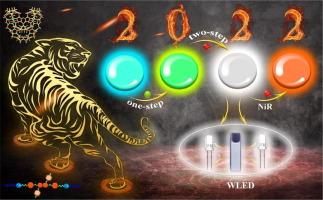Two-step, sequential, efficient, artificial light-harvesting systems based on twisted cucurbit[14]uril for manufacturing white light emission materials
Abstract
White-light-emitting (WLE) materials have promising and valuable applications in controllable lighting, screen displays and sensing. In this study, a two-step sequence of highly efficient artificial light-harvesting systems (ALHSs) with white light emission is successfully constructed in the aqueous phase through a non-covalent bond among imidazole derivatives (DIm), twisted cucurbit[14]uril (tQ[14]), eosin Y (ESY), and Nile red (NiR). The prepared linear supramolecular polymer (DIm@tQ[14]) constructed by DIm and tQ[14] through host–guest interaction is an ideal energy donor due to its superior aggregation-induced emission effect, which enables one-step energy transfer by loading ESY and two-step energy transfer by further loading NiR with a high efficiency of 91.47%. The emission color of the two-step sequential ALHSs changes from cyan to chartreuse then to orange-red, and bright white light emission can be achieved by controlling the donor/acceptor molar ratio. Moreover, the assemblies of the two-step sequential ALHSs can be applied to white LED materials. This research not only simulates the multi-step energy transfer process in nature but also has an attractive commercial value in the manufacturing of WLE materials.


 求助内容:
求助内容: 应助结果提醒方式:
应助结果提醒方式:


